02-test-bank - test PDF

| Title | 02-test-bank - test |
|---|---|
| Author | Anonymous User |
| Course | Microbiology |
| Institution | Texas A&M University-Corpus Christi |
| Pages | 18 |
| File Size | 317 KB |
| File Type | |
| Total Downloads | 16 |
| Total Views | 153 |
Summary
test...
Description
Microbiology: An Introduction, 12e (Tortora) Chapter 2 Chemical Principles 2.1 Multiple Choice Questions 1) Which of the following statements about the atom
C is FALSE?
A) It has 6 protons in its nucleus. B) It has 12 neutrons in its nucleus. C) It has 6 electrons orbiting the nucleus. D) Its atomic number is 6. E) Its atomic weight is 12. Answer: B Section: 2.1 Bloom's Taxonomy: Comprehension Learning Outcome: 2.1 Global Outcome: 2 2) Table 2.1 O
C
H
Using the information in Table 2.1, calculate the molecular weight of ethanol, C2H5OH. A) 96 B) 46 C) 34 D) 33 E) The answer cannot be determined. Answer: B Section: 2.1 Bloom's Taxonomy: Application Learning Outcome: 2.1 Global Outcome: 2
1 Copyright © 2016 Pearson Education, Ltd.
3) Antacids neutralize acid by the following reaction. Identify the salt in the following equation: Mg(OH)2 + 2HCl → MgCl2 + H2O A) Mg(OH)2 B) HCl C) MgCl2 D) H2O E) None of the answers is correct. Answer: C Section: 2.4 Bloom's Taxonomy: Comprehension Learning Outcome: 2.5 4) Which of the following statements is FALSE? A) Salts readily dissolve in water. B) Water molecules are formed by hydrolysis. C) Water freezes from the top down. D) Water is formed as a part of a dehydration synthesis reaction. E) Water is a polar molecule. Answer: B Section: 2.4 Bloom's Taxonomy: Knowledge Learning Outcome: 2.4 5) Which of the following is the type of bond holding K+ and I- ions in KI? A) ionic bond B) covalent bond C) hydrogen bond Answer: A Section: 2.2 Bloom's Taxonomy: Knowledge Learning Outcome: 2.2 6) Which of the following is the type of bond between molecules of water in a beaker of water? A) ionic bond B) covalent bond C) hydrogen bond Answer: C Section: 2.2 Bloom's Taxonomy: Comprehension Learning Outcome: 2.2 Global Outcome: 7
2 Copyright © 2016 Pearson Education, Ltd.
7) What is the type of bond holding hydrogen and oxygen atoms together in a single H2O molecule? A) ionic bond B) covalent bond C) hydrogen bond Answer: B Section: 2.2 Bloom's Taxonomy: Knowledge Learning Outcome: 2.2 8) Identify the following reaction: Glucose + Fructose → Sucrose + Water A) dehydration synthesis reaction B) hydrolysis reaction C) exchange reaction D) reversible reaction E) ionic reaction Answer: A Section: 2.5 Bloom's Taxonomy: Analysis Learning Outcome: 2.7 9) Identify the following reaction: Lactose + H2O → Glucose + Galactose A) dehydration synthesis reaction B) hydrolysis reaction C) exchange reaction D) reversible reaction E) ionic reaction Answer: B Section: 2.5 Bloom's Taxonomy: Analysis Learning Outcome: 2.7 10) Identify the following reaction: HCl + NaHCO3 → NaCl + H2CO3 A) dehydration synthesis reaction B) hydrolysis reaction C) exchange reaction D) reversible reaction E) ionic reaction Answer: C Section: 2.3 Bloom's Taxonomy: Analysis Learning Outcome: 2.7 Global Outcome: 2
3 Copyright © 2016 Pearson Education, Ltd.
11) Identify the following reaction: NH4OH ⇌ NH3 + H2O A) dehydration synthesis reaction B) hydrolysis reaction C) exchange reaction D) reversible reaction E) ionic reaction Answer: D Section: 2.3 Bloom's Taxonomy: Analysis Learning Outcome: 2.7 Global Outcome: 2 12) Which type of molecule contains the alcohol glycerol? A) carbohydrate B) phospholipids C) DNA D) protein Answer: B Section: 2.5 Bloom's Taxonomy: Knowledge Learning Outcome: 2.9 13) Which type of molecule is composed of (CH2O) units? A) carbohydrate B) lipid C) nucleic acid D) protein Answer: A Section: 2.5 Bloom's Taxonomy: Knowledge Learning Outcome: 2.8 14) Which type of molecule contains -NH2 (amino) groups? A) carbohydrate B) triglycerides C) nucleic acid D) protein Answer: D Section: 2.5 Bloom's Taxonomy: Knowledge Learning Outcome: 2.10
4 Copyright © 2016 Pearson Education, Ltd.
15) Which type of molecule NEVER contains a phosphate group? A) triglycerides B) phospholipid C) nucleic acid D) ATP Answer: A Section: 2.5 Bloom's Taxonomy: Comprehension Learning Outcome: 2.9 16) Based upon the valence numbers of the elements magnesium (2) and hydrogen (1), predict how many covalent bonds would form between these atoms to achieve the full complement of electrons in their outermost energy shells. A) one B) two C) three D) four Answer: B Section: 2.2 Bloom's Taxonomy: Analysis Learning Outcome: 2.2 Global Outcome: 2 17) Table 2.1 O
C
H
Using the information in Table 2.1, calculate the number of moles in 92 grams of ethanol, C2H5OH. A) 1 B) 2 C) 3 D) 4 E) The answer cannot be determined. Answer: B Section: 2.2 Bloom's Taxonomy: Analysis Learning Outcome: 2.2 Global Outcome: 4
5 Copyright © 2016 Pearson Education, Ltd.
18) Which of the following statements regarding protein structure is FALSE? A) The primary structure is formed by covalent bonding between amino acid subunits. B) Secondary structures are formed only from hydrogen bonds. C) Tertiary structures are formed only from covalent bonds. D) Quaternary structures involved multiple polypeptides. Answer: C Section: 2.5 Bloom's Taxonomy: Comprehension Learning Outcome: 2.10 19) Which of the following pairs is mismatched? A) NaOH ⇌ Na+ + OH- — base B) HF ⇌ H+ + F- — acid C) MgSO4 ⇌ Mg2+ + SO42- — salt D) KH2PO4 ⇌ K+ + H2PO4- — acid E) H2SO4 ⇌ 2H+ + SO42- — acid Answer: D Section: 2.3 Bloom's Taxonomy: Analysis Learning Outcome: 2.3 Global Outcome: 2 20) Table 2.2 NaOH ⇌ Na+ + OH- — base HF ⇌ H+ + F- - acid MgSO4 ⇌ Mg2+ + SO42- — salt KH2PO4 ⇌ K+ + H2PO4- — acid H2SO4 ⇌ 2H+ + SO42- — salt Which of the following statements about the reactions in Table 2.2 is FALSE? A) They are exchange reactions. B) They are ionization reactions. C) They occur when the reactants are dissolved in water. D) They are dissociation reactions. E) They are reversible reactions. Answer: A Section: 2.3 Bloom's Taxonomy: Analysis Learning Outcome: 2.3 Global Outcome: 2
6 Copyright © 2016 Pearson Education, Ltd.
21) What is the type of weak bond between the hydrogen of one molecule and the nitrogen of another molecule, where the two don't actively share an electron? A) ionic bond B) covalent bond C) hydrogen bond D) disulfide bond E) hydrophobic bond Answer: C Section: 2.3 Bloom's Taxonomy: Knowledge Learning Outcome: 2.2 Global Outcome: 7 22) What is the type of strong chemical bond between carbon, hydrogen, and oxygen atoms in a single organic molecule? A) ionic bond B) covalent bond C) hydrogen bond Answer: B Section: 2.3 Bloom's Taxonomy: Knowledge Learning Outcome: 2.2 Global Outcome: 7 23) What is the type of bond between ions in salt? A) ionic bond B) covalent bond C) hydrogen bond Answer: A Section: 2.3 Bloom's Taxonomy: Knowledge Learning Outcome: 2.2 Global Outcome: 7
7 Copyright © 2016 Pearson Education, Ltd.
24) A scientist wants to perform a test that will indicate whether a nucleic acid sample is composed of RNA or DNA. Testing for the presence of which of the following is most appropriate in this situation? A) phosphate B) nitrogen C) guanine D) uracil E) thymine Answer: D Section: 2.5 Bloom's Taxonomy: Comprehension Learning Outcome: 2.11 Global Outcome: 2 25) Structurally, ATP is most like which type of molecule? A) carbohydrate B) lipid C) protein D) nucleic acid Answer: D Section: 2.5 Bloom's Taxonomy: Comprehension Learning Outcome: 2.12 26) What do genes consist of? A) carbohydrates B) lipids C) proteins D) nucleic acids Answer: D Section: 2.5 Bloom's Taxonomy: Knowledge Learning Outcome: 2.11 Global Outcome: 7 27) Which molecule is composed of a chain of amino acids? A) carbohydrate B) lipid C) protein D) nucleic acid Answer: C Section: 2.5 Bloom's Taxonomy: Knowledge Learning Outcome: 2.10
8 Copyright © 2016 Pearson Education, Ltd.
28) Which are the primary molecules making up plasma membranes in cells? A) carbohydrates B) lipids C) proteins D) nucleic acids Answer: B Section: 2.5 Bloom's Taxonomy: Knowledge Learning Outcome: 2.9 Global Outcome: 7 29) The antimicrobial drug imidazole inhibits sterol synthesis. This would most likely interfere with A) bacterial cell walls. B) fungal cell walls. C) eukaryotic plasma membranes. D) prokaryotic plasma membranes. E) genes. Answer: C Section: 2.5 Bloom's Taxonomy: Analysis ASMcue Outcome: 3.4 Learning Outcome: 2.9 Global Outcome: 2
9 Copyright © 2016 Pearson Education, Ltd.
Figure 2.1
30) In Figure 2.1, which is an alcohol? A) a B) b C) c D) d E) e Answer: C Section: 2.5 Bloom's Taxonomy: Analysis Learning Outcome: 2.7 Global Outcome: 3 31) Which compound in Figure 2.1 is an ester? A) a B) b C) c D) d E) e Answer: D Section: 2.5 Bloom's Taxonomy: Analysis Learning Outcome: 2.7 Global Outcome: 3
10 Copyright © 2016 Pearson Education, Ltd.
32) Which compound in Figure 2.1 is an organic acid? A) a B) b C) c D) d E) e Answer: A Section: 2.5 Bloom's Taxonomy: Analysis Learning Outcome: 2.6 Global Outcome: 3 33) Most amino acids found in cells demonstrate what type of chirality? A) L-isomers B) D-isomers C) C-isomers D) B-isomers E) A-isomers Answer: A Section: 2.5 Bloom's Taxonomy: Knowledge Learning Outcome: 2.10
11 Copyright © 2016 Pearson Education, Ltd.
34) Figure 2.3
What kind of bond is at the arrow in Figure 2.3? A) disulfide bridge B) double covalent bond C) hydrogen bond D) ionic bond E) peptide bond Answer: E Section: 2.5 Bloom's Taxonomy: Analysis Learning Outcome: 2.10 Global Outcome: 3 35) An E. coli culture that has been growing at 37°C is moved to 25°C. Which of the following changes must be made in its plasma membrane to help it cope with the decrease in temperature? A) The number of phosphate groups must increase. B) The viscosity must increase. C) The number of saturated chains must increase. D) The number of unsaturated chains must increase. E) No changes are necessary. Answer: D Section: 2.5 Bloom's Taxonomy: Comprehension Learning Outcome: 2.9
12 Copyright © 2016 Pearson Education, Ltd.
36) Radioisotopes are frequently used to label molecules in a cell. The fate of atoms and molecules in a cell can then be followed. Assume Saccharomyces cerevisiae is grown in a nutrient medium containing the radioisotope 35S. After a 48-hour incubation, the 35S would most likely be found in the S. cerevisiae's A) carbohydrates. B) nucleic acids. C) water. D) lipids. E) proteins. Answer: E Section: 2.5 Bloom's Taxonomy: Comprehension Learning Outcome: 2.10 Global Outcome: 2 37) Radioisotopes are frequently used to label molecules in a cell. The fate of atoms and molecules in a cell can then be followed. Assume Saccharomyces cerevisiae is grown in a nutrient medium containing the radioisotope 32P. After a 48-hour incubation, the majority of the 32P would be found in the S. cerevisiae's A) plasma membrane. B) cell wall. C) water. D) proteins. E) carbohydrates. Answer: A Section: 2.5 Bloom's Taxonomy: Comprehension Learning Outcome: 2.9 Global Outcome: 2 38) Starch, dextran, glycogen, and cellulose are polymers of A) amino acids. B) glucose. C) fatty acids. D) nucleic acids. E) acids. Answer: B Section: 2.5 Bloom's Taxonomy: Knowledge Learning Outcome: 2.8
13 Copyright © 2016 Pearson Education, Ltd.
39) Which of the following is a base? A) C2H5OCOOH → H+ + C2H5OCOOB) C2H5OH C) NaOH → Na+ + OHD) H2O → H+ + OHE) H2CO Answer: C Section: 2.4 Bloom's Taxonomy: Analysis Learning Outcome: 2.6 Global Outcome: 2 40) Two glucose molecules are combined to make a maltose molecule. What is the chemical formula for maltose? A) C3H6O3 B) C6H12O6 C) C12H24O12 D) C12H22O11 E) C12H23O10 Answer: D Section: 2.5 Bloom's Taxonomy: Comprehension Learning Outcome: 2.8 Global Outcome: 3 41) If an amino acid contained a hydrocarbon (a group of multiple carbons and hydrogens linked together) as its side group, in which of the following categories could it be appropriately designated? A) hydrophilic B) polar C) nonpolar D) basic E) acidic Answer: C Section: 2.5 Bloom's Taxonomy: Analysis Learning Outcome: 2.10 Global Outcome: 2
14 Copyright © 2016 Pearson Education, Ltd.
2.2 True/False Questions 1) Elements only achieve the full complement of electrons in outermost energy cells by donating away or sharing electrons. Answer: FALSE Section: 2.1 Bloom's Taxonomy: Comprehension Learning Outcome: 2.1 2) Covalent bonds are always shared equally. Answer: FALSE Section: 2.1 Bloom's Taxonomy: Knowledge Learning Outcome: 2.2 Global Outcome: 7 3) Individual covalent bonds are stronger than individual ionic bonds. Answer: TRUE Section: 2.1 Bloom's Taxonomy: Knowledge Learning Outcome: 2.2 4) All chemical reactions are, in theory, reversible. Answer: TRUE Section: 2.3 Bloom's Taxonomy: Knowledge Learning Outcome: 2.3 5) The formation of ADP from ATP can be defined as a hydrolytic reaction. Answer: TRUE Section: 2.3 Bloom's Taxonomy: Knowledge Learning Outcome: 2.12 6) The density of liquid water is greater than the density of ice. Answer: TRUE Section: 2.4 Bloom's Taxonomy: Knowledge Learning Outcome: 2.4 7) A basic solution is expected to contain more hydrogen ions than hydroxyl ions. Answer: FALSE Section: 2.4 Bloom's Taxonomy: Comprehension Learning Outcome: 2.5 Global Outcome: 7 15 Copyright © 2016 Pearson Education, Ltd.
8) All forms of life function optimally at a pH of 7. Answer: FALSE Section: 2.4 Bloom's Taxonomy: Knowledge Learning Outcome: 2.5 9) There are some forms of life on Earth that can survive without water. Answer: FALSE Section: 2.4 Bloom's Taxonomy: Knowledge Learning Outcome: 2.4 Global Outcome: 2 10) Any compound that contains carbon is considered to be strictly organic. Answer: FALSE Section: 2.4 Bloom's Taxonomy: Knowledge Learning Outcome: 2.6 Global Outcome: 2 2.3 Essay Questions 1) Describe how the properties of phospholipids make these molecules well suited for plasma membranes. Section: 2.5 Bloom's Taxonomy: Synthesis Learning Outcome: 2.9 Global Outcome: 8
16 Copyright © 2016 Pearson Education, Ltd.
2) Figure 2.5
Use Figure 2.5 to answer the following. Starch, cellulose, dextran, and glycogen are polysaccharides. How are they similar? To what are their different properties due? Why can't an enzyme that hydrolyzes starch degrade cellulose? Section: 2.5 Bloom's Taxonomy: Synthesis Learning Outcome: 2.8 Global Outcome: 8
17 Copyright © 2016 Pearson Education, Ltd.
3) Compare a molecule of a nucleotide to ATP. Could a cell simply insert ATP into DNA without altering it? Explain. Section: 2.5 Bloom's Taxonomy: Synthesis Learning Outcome: 2.12 Global Outcome: 8 4) A scientist claims that when a protein is denatured, it can be expected that its secondary structure will more likely be retained when compared to all other levels of protein structure structures. Do you agree? Explain. Section: 2.5 Bloom's Taxonomy: Evaluation Learning Outcome: 2.10 Global Outcome: 8 5) A bacterium that grows at a temperature of 37°C transports both glucose and NaCl into its cytoplasm. Which is most easily dissolved in the cytoplasm? Explain how the bonds of these molecules impact disassociation rate. Section: 2.5 Bloom's Taxonomy: Analysis Learning Outcome: 2.6 Global Outcome: 8
18 Copyright © 2016 Pearson Education, Ltd....
Similar Free PDFs
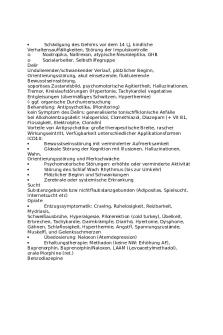
Test - test
- 1 Pages
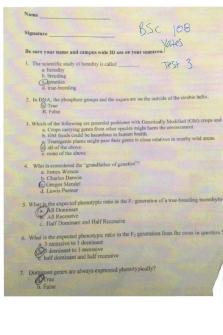
Yates Test 3 - Test
- 7 Pages
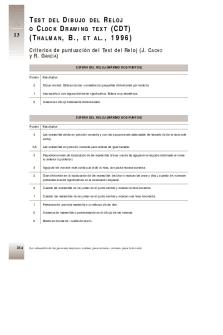
Test-reloj - test
- 4 Pages
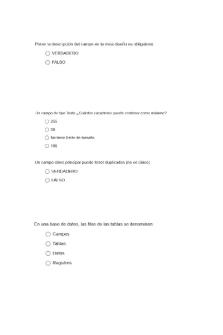
Test Access 2010 - Test
- 6 Pages
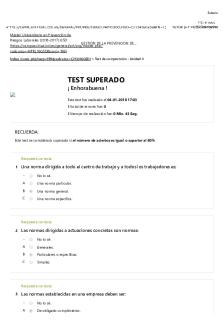
Resultado Test 842 - TEST
- 2 Pages
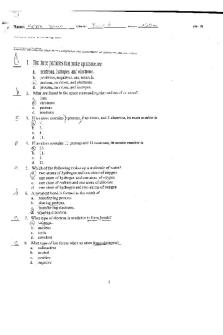
AP. Bio. Test - test
- 4 Pages
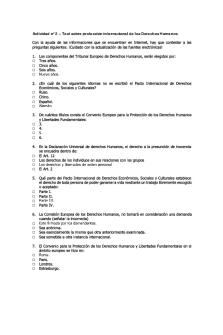
Test
- 4 Pages
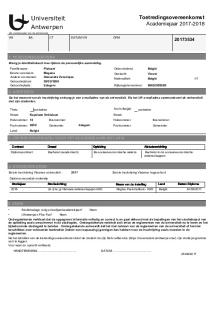
TEST
- 1 Pages

Chapter 4-test - test
- 23 Pages
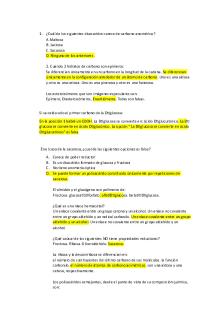
Test preguntas - test
- 4 Pages
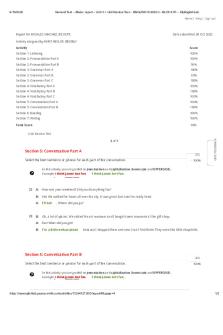
Test 3 - 5 - test
- 2 Pages

PET TEST Full Test
- 35 Pages

Preguntas TEST - CG - Test
- 4 Pages

Test leccion 3 - Test
- 3 Pages
Popular Institutions
- Tinajero National High School - Annex
- Politeknik Caltex Riau
- Yokohama City University
- SGT University
- University of Al-Qadisiyah
- Divine Word College of Vigan
- Techniek College Rotterdam
- Universidade de Santiago
- Universiti Teknologi MARA Cawangan Johor Kampus Pasir Gudang
- Poltekkes Kemenkes Yogyakarta
- Baguio City National High School
- Colegio san marcos
- preparatoria uno
- Centro de Bachillerato Tecnológico Industrial y de Servicios No. 107
- Dalian Maritime University
- Quang Trung Secondary School
- Colegio Tecnológico en Informática
- Corporación Regional de Educación Superior
- Grupo CEDVA
- Dar Al Uloom University
- Centro de Estudios Preuniversitarios de la Universidad Nacional de Ingeniería
- 上智大学
- Aakash International School, Nuna Majara
- San Felipe Neri Catholic School
- Kang Chiao International School - New Taipei City
- Misamis Occidental National High School
- Institución Educativa Escuela Normal Juan Ladrilleros
- Kolehiyo ng Pantukan
- Batanes State College
- Instituto Continental
- Sekolah Menengah Kejuruan Kesehatan Kaltara (Tarakan)
- Colegio de La Inmaculada Concepcion - Cebu

